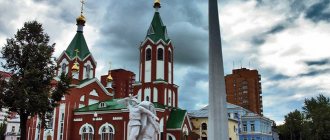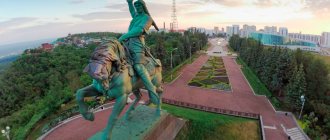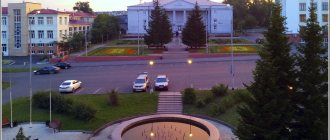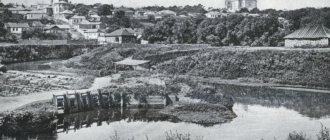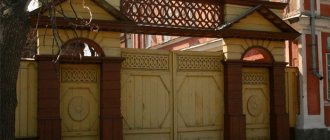Russia \ Volzhsky \ Attractions
The city of Volzhsky is one of the largest cities in the Volgograd region, as well as a large industrial center of the Lower Volga region with a population of 314.4 thousand people. The city is located on the bank of Akhtuba, 20 km from Volgograd. According to the results of the all-Russian competition “The most comfortable city in Russia”, held in 2004, the city of Volzhsky was awarded the title of the greenest city among cities with a population of up to 500,000 inhabitants. Due to the fact that the city does not have such a long history, the attractions of Volzhsky are relatively young; most of the interesting places in the city are not even 50 years old.
The construction of Volzhsky is inextricably linked with the construction of the Volzhskaya hydroelectric station: it was the creation of a hydroelectric power station that served as the impetus for the construction of Volzhsky. The oldest building in the city is a hundred-year-old school, which currently houses an art gallery. Volga residents relax on Lenin Square, VGS Park and Fontannaya Street, visit the local history museum and exhibition hall. There are many religious attractions in Volzhsky: among all the churches and temples in Volzhsky, the most famous is the Church of St. John the Evangelist. And lovers of culture, history and monumental creativity will be interested in such sights as the Volzhsky monuments. Those interested in industrialism will find the Volzhskaya Hydroelectric Power Station and the old river station.
Transport-geographical location
Located in the south of the Volgograd region, on the Caspian lowland, on the left bank of the Volga River, at the beginning of its left branch - the Akhtuba River, 20 km northeast of Volgograd.
The Caspian highway (Moscow - Astrakhan) passes through the city, and the Volzhsky - Samara highway originates here. Railway station (1964; electrified in 2003) on the Volgograd – Astrakhan line. River port (freight transportation: transit and local; structural division of the Volgograd river port). Tram (1963).
Enterprises and industry of Volzhsky
Volzhsky is often awarded not only the title of the most comfortable city in Russia, but also the city of chemists: this nickname was given to Volzhsky due to the large concentration of factories and industrial enterprises in Volzhsky. The city is one of the largest industrial centers in the Lower Volga region; today there are over 30 industrial enterprises in various fields in the city: chemical (Volzhskoe chemical fiber, Volzhskrezinotekhnika), food (Volzhsky biscuit, Volzhsky meat processing plant), energy ( Hydroelectric power stations, thermal power plants 1 and 2) and the engineering industry (Energotekhmash, Volzhanin bus production), as well as the production of ferrous metallurgy (Volzhsky Pipe Plant).
Due to this oversaturation of Volzhsky with industrial enterprises, the city has many environmental problems, among which the heavy gas pollution of the airspace stands out. In 2005, the environmental service recorded an excess of all standards for emissions of substances such as hydrogen sulfide and carbon monoxide. However, in Volzhsky they are trying to monitor the environmental situation and in every possible way prevent any excess emissions of harmful substances: so in 2006, a special “SKAT” device was installed on one of the streets of Volzhsky, which continuously monitors the state of the atmosphere in the city. In addition, batches of new trees are planted in the city every year: in many ways, this saves Volga residents from severe air pollution, and in the summer it gives coolness and freshness. And it is precisely thanks to such large-scale greening of the urban environment that for five years in a row Volzhsky was awarded several awards at the competition “The Most Comfortable City in Russia”, at one of which Volzhsky was named the greenest and cleanest city among cities with a population of up to half a million inhabitants.
Science and education
Volzhsky Institute of Economics, Pedagogy and Law (2000); branches of Russian universities: Polytechnic Institute (1965; branch of Volgograd State Technical University; in 2015 it included the Institute of Construction and Technology, 1954 - the oldest university in the city), Humanitarian Institute (1992; branch of Volgograd State University), branches of the Moscow Energy Institute (1995 ), International Law Institute (1999; Moscow), etc.
Central City Library (1957).
Churches, temples and other holy places of Volzhsky:
Temple of St. John the Evangelist In the city of Volzhsky, many churches and temples have been built recently. One of the last new buildings of such significance was the Church of St. John the Evangelist in the city of Volzhsky. In 1991, the first stone of the building was laid and the parish was created. Read more…
Churches and temples of Volzhsky There are about 10 temples and churches of Volzhsky. The very first and famous temple in Volzhsky is the Temple of Seraphim of Sarov. Other Volzhsky churches: the Church of St. John the Evangelist, the Church of the Nativity of Christ. Read more…
Farm
The basis of the city's economy is industrial production. Leading industries: electric power, ferrous metallurgy, chemical, mechanical engineering and food processing. The main power generating capacities: Volzhskaya HPP (1961; lower in the Volga cascade; capacity 2671 MW), gas and oil CHPP-1 (1962; 541 MW) and CHPP-2 (1988; 240 MW). Among the largest industrial enterprises are pipe-rolling plants: Volzhsky Pipe (1970; one of the country's leading producers of steel pipes), Profil-Akras Pipe Plant named after. V.V. Makarova (1991) and pipe-profile (2005; profile pipes and small-diameter pipes); (1964; aniline, methionine, carbon disulfide, flotation reagents, gasoline additives, etc.), tire "Voltyre-Prom" (1964; until 1992 named after the 50th anniversary of the formation of the USSR), regenerative tire repair (1961), "Volzhskrezinotekhnika" ( high-pressure rubber hoses), Gazprom Khimvolokno (1966; cord and technical fabrics), Polyplastic Povolzhye (polyethylene pipes), nitrogen-oxygen, EKTOS-Volga (high-octane additives for motor gasoline), bearing (1961) holding "Volgabus" (history dates back to 1993, current status since 2008; production of buses for various purposes of the "Cityrhythm" brand; capacity of about 500 units per year), car mufflers, "Meteor" (quartz resonators), "Energotekhmash" (prefabricated collapsible residential complexes), "Volgograd Aluminum Company - Powder Metallurgy" ("Valcom-PM"; aluminum powders and powders), steel structures, "Volga Industrial Complex" (gas cylinders and metal containers), asbestos technical products and abrasive. The food-flavoring industry is represented by bakeries, dairy and cheese-making plants, a brewery and other enterprises.
Cultural, historical sights and monuments of Volzhsky:
Lenin Square Lenin Square was built in the early 80s. The central square of the city of Volzhsky is a vast recreation area, decorated with numerous fountains and framed by a green area. Read more…
Old school and art gallery The old school was built in 1881 at the expense of village residents in the very center of Bezrodnoye. Now the Volzhsky art gallery is located in the old school building. Read more…
Palace of Culture DK "October" DK "October" is known to Volzhsky residents as the largest center of culture and recreation in the city of Volzhsky. The official opening of the Oktyabr Palace of Culture in Volzhsky took place in October 1977. The history of the creation of the October Palace of Culture is very interesting. Read more…
Fontannaya Street Fontannaya Street is one of the most beautiful and quiet streets in the city of Volzhsky. The end of Fontannaya Street is a monument to the first builders of the city, erected on the initiative of the first builders themselves and with the support of the Volzhsky administration. Read more…
Palace of Pioneers The grand opening of the Volga Palace of Pioneers took place in October 1967. At the moment, the Volga Palace of Pioneers is not only the largest leisure and recreation center for young people in the city, but also the winner of numerous competitions. Read more…
DK VGS and park of culture and recreation The construction of the Palace of Culture "VolgogradGidrostroy" (DK VGS) in Volzhsky was conceived in 1952. The first event, held in the still unfinished building of the VGS Palace of Culture, took place on November 6, 1955. Behind the palace of culture there is a park of culture and recreation. Read more…
Loginov Stadium The Loginov Central Stadium in the city of Volzhsky, named after the founder of the city, has been the center of sports in our city for more than half a century. The construction of the Loginov Stadium in Volzhsky was launched simultaneously with the construction of the first houses. Read more…
Monuments to Volzhsky Despite the relatively short history of Volzhsky’s life, there are about 20 memorial buildings in the city and their number continues to grow over the years. It is Volzhsky’s monuments, like nothing else, that help us learn the history of the city. Read more…
History of Volzhsky: Loginov's master plan
According to Fyodor Georgievich’s plan, the village of hydroelectric power station builders was to become the “southern Venice”
On February 18, Volzhsky celebrated the 120th anniversary of the birth of its founder, Fyodor LOGINOV. In many ways, this is a figure misunderstood and even underestimated. The press cultivates the image of the head of a large construction project, a talented organizer, a son of his era, but in fact, the scale of Fyodor Georgievich’s personality exceeded all these templates. He was not only a strategist, but also a dreamer, a romantic, a caring father and just a good person. Today we decided to talk about the “little-known Loginov” and how he wanted to see the “Volzhsky of the future”.
THE POWER OF A WORD
At the exhibition “History in Documents”, which is now running in the Volga Museum of History and Local Lore, there is a unique exhibit - a transcript of Fyodor Loginov’s speech to participants and visitors of the Regional Industrial and Agricultural Exhibition in 1950.
Fyodor Georgievich spoke, of course, about the Stalingrad Hydroelectric Power Station. Amazed listeners learned that the builders’ village was planned to be irrigated with ditches and canals, and the “construction of the century” would be completed in five years – in 1956.
“The text, typewritten, was all scribbled out, dotted with corrections—the head of Stalingradhydrostroy continued to work with it even after the speech,” says senior researcher at the museum Ekaterina LOSKUTOVA. “Please note: in the same display case there is a note from the executive secretary of the Stalingrad branch of the All-Union Review Society political and scientific knowledge: “Your lecture is in great need in the periphery.” It was subsequently proposed to be published in large quantities and distributed to the masses.
Note from the executive secretary
Loginov was not only an outstanding hydraulic engineer, but also an excellent speaker and propagandist. In 1925, he attended provincial retraining courses for propaganda workers and volzhenorganizers (volost women's organizers). Subsequently, this experience was useful to him. He gave lectures and reports, wrote articles about energy achievements for newspapers and scientific journals. The publications had a resonance: after reading them, many people came to the “construction site of the century” who wanted to “give their knowledge and experience for the good of the Motherland,” as future Volga residents wrote in their questionnaires.
TWO THOUSAND CARS DAILY
We offer excerpts from Loginov’s multi-page speech. In essence, it was planned to create a large-scale industrial and energy complex in the lower reaches of the Volga - with all the necessary infrastructure. The Stalingrad hydropower hub in Fyodor Georgievich’s plans looked like this: “From the right bank, going deeper into the river, 1,300 - 1,400 meters, an earthen alluvial dam 45 meters high and 460 meters wide at the base will be built. The top of the dam will have a width of over 25 meters - a railway and a highway, a wide, mainline, well-maintained overpass will be laid along it... The hydroelectric station will generate over 10 billion kilowatt-hours of electrical energy per year, with an installed station capacity of about 1,700 tons kW . Electric energy will be of three voltages: 400 thousand volts - for Moscow, 230 thousand volts - in distant areas, in particular, in Saratov and the Voronezh region, and 110 thousand volts will be consumed locally - in Stalingrad and the Stalingrad region... The hydroelectric power station building will have a length about 700 meters and a height of 64 meters - the size of a 15-story building. It is planned to attach a single-chamber lock to it on the left so that all ships and rafts coming from top to bottom and bottom to top can pass through without delay. 17 or 19 hydraulic units of unique capacity today will be installed in the station building.”
Minister's certificate
In terms of scale, the Stalingrad Hydroelectric Power Station is much larger than the Dnieper Hydroelectric Station, which until that time was considered the largest in Europe. Its construction required at least 44 million tons of various materials. It was planned to deliver them by water and by rail - up to 2,000 wagons daily. Since the Ryazan-Ural and Stalingrad highways could not cope with such a flow, Loginov proposed to immediately begin their reconstruction...
ABOUT THE GRAVITY IRRIGATION CANAL
“...This will be a grandiose structure 650 kilometers long, designed to flow about 400 cubic meters of water per second - at the beginning, with a decrease in flow as it moves away. In the areas where this canal will pass, the country... will have the opportunity to create flowering gardens, industrial oak forests and receive good harvests... In order to dig this canal, it will take five years of work by 300 excavators, which will remove 400 million cubic meters of earth”...
WELL-PREPARED REAR
In order for the construction to proceed successfully, according to Loginov, “well-prepared rear areas” were required: housing for workers, office workers and engineering and technical personnel...
It was planned to build comfortable houses “with the latest technology and architecture” for 150 thousand people, cultural institutions, clubs, a Palace of Culture, schools for children of workers and employees, a stadium, a park, kindergartens, nurseries, clinics and hospitals.
Transcript of the lecture with editing by Loginov
Shops, baths, laundries, hairdressers, greenhouses and tree nurseries - everything connected with the life of cultured Soviet people. The construction of large industrial enterprises, including a concrete plant, also went without saying: it was vitally necessary. According to specialists’ calculations, on average it was planned to lay about 2,750 thousand cubic meters of concrete - 5.5 times more than at the Dnieper Hydroelectric Station, “which is something that world practice has not known for its long history.”
LEFT BANK, RIGHT BANK
“Scientists from a number of scientific institutions are working with us on how to solve the problem of transferring construction materials from shore to shore. Apparently, in addition to the railway ferry, we will have several strings of a cable car across the Volga... A small but complex railway economy with all its branches will be established: track, traction, carriage management and operation of railways...”
ROADS AND TRANSPORT
Loginov mentioned “many, many tens of kilometers of intra-building and intra-village highways.”
It was specifically stipulated that roads were needed “durable, well-maintained, and asphalted—which means a powerful asphalt plant will be needed.” The construction of a mechanical enterprise was envisaged, where it would be possible to organize the repair of construction mechanisms and the production of spare parts and a number of products, and the opening of automobile repair shops.
Invitation card to all meetings of the XX Congress of the CPSU
WATER WILL COME TO THE STEPPE
“The construction of a new village is planned in the Verkhnyaya Akhtuba area. We plan to build 5-6 parallel streets, each several kilometers long, dissected every 200 meters by perpendicular short streets. At the top of them... there will be a command irrigation canal into which we will pump water from Akhtuba in significant quantities. Then this water will spread through channels that will run along each street, on each side - along a canal, along a ditch. Trees will be planted along the ditches. To do this, we will organize a large nursery, and secondly, a number of large trees will be transplanted from the flood zone.
We think that this way we will be able to nourish the root system and soil with moisture, from where these trees must get their food. Thus, in a place that is now essentially a desert, in a couple of years there will be blooming gardens.”
Minister of Power Plant Construction. 1954
Work for communism
“When and how will our main structures be built?
In 1951, we must build a significant number of the rear facilities that I have listed, that is, ancillary enterprises, housing stock, social, cultural and communal buildings and institutions. From the second half of 1951 it will be necessary to begin the main work: we will begin digging a pit for the dam and the station building... In 1952 we will finish the pit completely. 1954 is the most intense year... We must install about 15 thousand tons of metal structures and prepare for the installation of main equipment. In 1955, we will have to begin work on throwing stones into the flowing water of the existing Volga channel so that after the 1956 flood passes, we will immediately begin to fill the earthen part of the dam from the right bank. On the left bank, by this time the earthen embankment should be completed, the installation of equipment should proceed in a wide front, and rafts and ships should already be moving through the locks. And in 1956, the waters of the Volga should already work for communism, for the benefit of our socialist Motherland!” Life made its own adjustments to these plans. Instead of six years, the construction of the Stalingrad waterworks continued for another five years. And the water did not flow through the ditches and canals of the workers’ village, but the handsome Volzhsky appeared - not with barracks, but with all sorts of, in Khrushchev’s words, “architectural excesses.” And according to Loginov, it was and remains a city “built according to the latest word in architecture.”
Geography
The area is located in the northeastern part of the city and borders on the west with the Kirovsky, Frunzensky and Oktyabrsky districts, and on the east the border is delineated by the Volga. The bridge across the Volga begins from Predmostovaya Square, connecting Saratov with Engels and being one of the longest in Europe. The total area of the district is 95 square kilometers; there are both historical neighborhoods that were formed immediately after the founding of Saratov, as well as modern villages and microdistricts. The Volzhsky district includes the villages of 2nd Guselka, Dalny Zaton, Zaton, Zonalny, Emerald City, Novosokolovogorsky, Pchelka, Secha, Sokolovogorsky, Yubileiny. The largest highways are the Ust-Kurdyumskoe highway, Moskovskaya, Radishcheva and Chernyshevsky streets. The main public transport hub is Museum Square. In the area there is a river station and Volga beaches.
Emergence of the settlement
The exact number of development of the area has not been established. In all likelihood, it begins in the 14th century
V. In the Volga steppes there were at least several villages of the Golden Horde, as well as Nogais and Kalmyks. During the era of Peter the Great, Russian colonists explored the lower Volga, forcing the Kalmyk khans to move downstream to Akhtuba.
In the middle of the XVIII
V.
In these parts they were engaged in sericulture. Fugitive peasants willingly worked on mulberry plantations, acquiring the status of government workers. From 1766
to
1800
_
A silk production enterprise operated here. In the 17th
century in the southeast of the current area there was the village of Bezrodnoye. Thanks to the river flowing nearby, it was often called Upper Akhtuba.
Due to the favorable location, the number of residents is up to 1917
was approaching
2
tens of thousands. During the Battle of Stalingrad, it was completely destroyed by the Nazis, leaving no buildings, with the exception of a half-surviving school and mill.
Hymn
Our sun rises high, Playing in the Orthodox domes. The city floats like a white swan, over the expanse of wormwood land. A page of miracles opened, And palaces and factories stood up. A mighty hydroelectric power station was rising on hands stronger than stone and steel.
Chorus: The flag flies proudly: two rivers wave, We live under a happy star. My homeland, I am proud of you, the Volga garden city has become my destiny!
We keep the names of veterans. Continuing the great work, So that the heart sings Glory to the city of Volga at all times. The eight-winged star is shining, leading to a new life. Volzhsky is in my heart forever - the Glorious city of the great Fatherland.
Words and music by E. Kryukov.
Approved on May 28, 2010.


